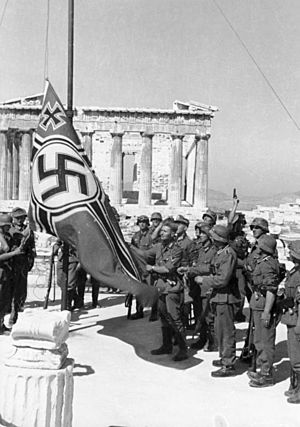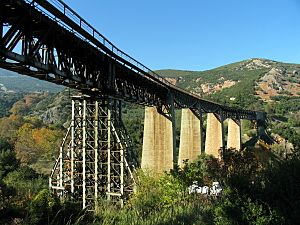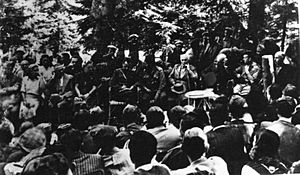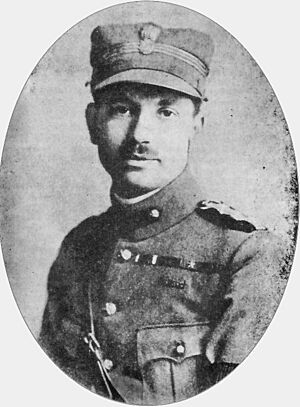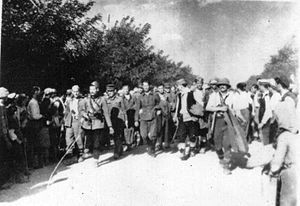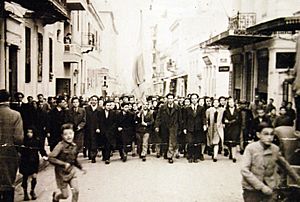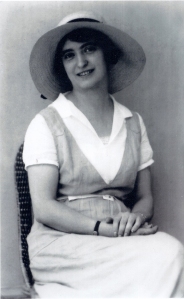Greek resistance facts for kids
Quick facts for kids Greek resistance |
|||||||
|---|---|---|---|---|---|---|---|
| Part of the Balkans Campaign of World War II and the Resistance against the Axis Powers | |||||||
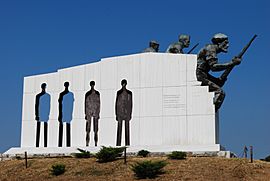 Memorial to the Greek Resistance on the road to Distomo |
|||||||
|
|||||||
| Belligerents | |||||||
Secessionist groups: Roman Legion (until Sep. 1943) |
and others... Supported by: |
||||||
| Commanders and leaders | |||||||
Alcibiades Diamandi Nicolaos Matussis |
|||||||
| Strength | |||||||
| A total of 205,000+ men: 25,000 men of Security Battalions, Poulos Verband etc |
|
||||||
| Casualties and losses | |||||||
8,000 injured (in total) 6,463 POW Unknown number of collaborators 36,270+ total casualties |
In total 20,650 partisans killed 10,000 injured (in total) |
||||||
| 50,000–70,000 civilians executed c.65,000 (including 60,000 Jews) were deported, of whom a small number survived (40,000 died during the Great Famine) |
|||||||
The Greek Resistance (called Ethnikí Antístasi in Greek, meaning "National Resistance") was a movement of groups and people who fought against the occupation of Greece during World War II. This happened from 1941 to 1944. These groups included both armed fighters and unarmed people.
The largest group was the EAM and its army, the ELAS. This group was mostly led by Communists. The Greek Resistance was one of the strongest resistance movements in Nazi-occupied Europe. Its fighters, known as andartes, controlled much of the countryside before the Germans left Greece in late 1944.
Contents
Why the Resistance Started
The resistance movements in Greece began after Nazi Germany and its allies, Italy and Bulgaria, invaded and took over Greece. This occupation lasted from 1941 to 1944. Italy first tried to invade Greece in 1940, but the Greek Army pushed them back.
After Germany invaded and took over Athens, the Greek King and his government went to Egypt. There, they formed a government-in-exile that the Allies recognized. Meanwhile, the Germans set up a Greek government in Greece that worked with them. This government was not popular because it depended on the Germans and Italians. It also failed to stop a terrible famine in the winter of 1941–42, which caused many deaths.
First Acts of Defiance
One of the first acts of resistance happened on May 30, 1941. Two young students, Apostolos Santas and Manolis Glezos, secretly climbed the Acropolis. They took down the German swastika flag that the occupiers had placed there. This act became a symbol of defiance.
Later, in September 1941, a large uprising happened in Drama, in eastern Macedonia. This area was controlled by Bulgaria, which was trying to make the Greek people there more like Bulgarians. The revolt was put down harshly by the Bulgarian Army. Thousands of people were killed, and many villages were destroyed.
Forming Resistance Groups
Since there was no strong Greek government in charge, many new groups formed to fight the occupation. Most officers and citizens who wanted to keep fighting went to the British-controlled Middle East. Those who stayed were unsure how to fight the powerful German army.
One of the first groups was the Grivas Military Organization, started in June 1941. Another was "Freedom," led by Colonel Dimitrios Psarros, in July 1941. In Crete, the "Supreme Committee of Cretan Struggle" (AEAK) was also formed in June 1941.
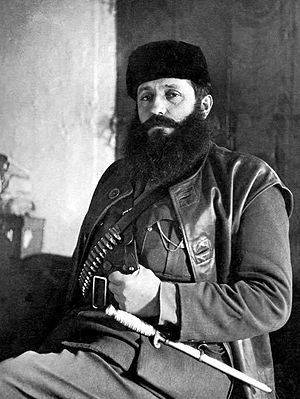
The biggest resistance group was the National Liberation Front (EAM). By 1944, it had over 1.8 million members, out of a total Greek population of about 7.5 million. EAM was started by the Communist Party of Greece (KKE) and other smaller groups. In February 1942, EAM formed its armed wing, the Greek People's Liberation Army (ELAS), led by Aris Velouchiotis.
The second largest group was the National Republican Greek League (EDES). It was led by Colonel Napoleon Zervas. Another important group was National and Social Liberation (EKKA), led by Colonel Dimitrios Psarros.
Fighting in the Mountains – Andártiko
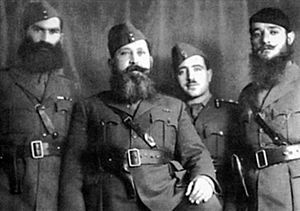
Greece is a very mountainous country. This made it a good place for andartiko (guerrilla warfare), which means fighting in small groups using surprise attacks. This type of fighting has a long history in Greece. By 1942, the countryside was becoming less controlled by the government in Athens. Resistance groups grew strong and organized.
Armed Resistance Grows
In February 1942, ELAS began operating in the mountains of Central Greece. Later, in July 1942, EDES formed its military arm, the National Groups of Greek Guerrillas (EOEA), in the Aetolia-Acarnania region. EKKA also formed a military group, the 5/42 Evzone Regiment.
At first, the occupation forces, especially the Italians, didn't worry much about the armed resistance. But from mid-1942, the resistance grew quickly. Armed groups attacked police stations and Italian outposts. They also visited villages to give patriotic speeches. The Italians then started sending Greek army officers to camps, which made more officers join the resistance.
The Greek Resistance became known worldwide with a big act of sabotage: the blowing up of the Gorgopotamos railway bridge on November 25, 1942. This bridge connected northern and southern Greece. British agents and fighters from both ELAS and EDES worked together on this mission, called "Operation Harling". This was one of the few times these two main resistance groups cooperated.
Establishing "Free Greece"
The resistance groups continued their attacks, like the Battle of Fardykampos, where they captured many Italian soldiers and equipment. By the spring of 1943, the Italians had to leave several areas. Towns like Karditsa and Grevena were freed by July. The Axis forces only controlled the main towns and roads. The rest of the countryside became "Free Greece". This was a large area of about 30,000 square kilometers with 750,000 people.
Italian Surrender and German Takeover
By July 1943, the andartes had about 20,000 to 30,000 fighters, with most belonging to ELAS. When Italy surrendered in September 1943, the resistance groups gained a lot. Many Italian soldiers were disarmed by the Germans. However, in some places, like Cephalonia, Italian troops fought the Germans. In other areas, Italian weapons and equipment fell into the hands of the resistance.
The Germans then took over the areas previously held by the Italians. They were much tougher opponents. German troops came into Greece, fearing an Allied landing. They began harsh operations against the guerrillas. They carried out mass killings of civilians, like the Massacre of Kalavryta in December 1943 and the Massacre of Distomo in June 1944. Hundreds of villages were burned, and nearly a million people lost their homes.
Growing Conflicts Among Resistance Groups
Even though the main resistance groups agreed to work together in July 1943, they didn't trust each other. EAM/ELAS was the strongest group. EDES and EKKA, along with the British, worried that EAM would try to control Greece after the Germans left. The British also didn't want Communists to take over Greece.
The Germans and their Greek helpers also attacked EAM. The new Greek government working with the Germans formed special units called Security Battalions to fight only ELAS. Other anti-communist groups also received weapons and money from the British.
A kind of civil war began even while the Germans were still there. In October 1943, ELAS attacked EDES in Epirus. This fighting continued until February 1944, when a ceasefire was agreed upon. However, fighting continued between ELAS and other smaller resistance groups, as well as against the Security Battalions. In March 1944, EAM set up its own government in "Free Greece," showing it wanted a big role in post-war Greece.
In April 1944, ELAS forces attacked and destroyed EKKA's 5/42 Regiment. They captured and executed many of its men, including its leader, Colonel Dimitrios Psarros. This event shocked many Greeks and made many people distrust EAM's plans for the future.
Resistance in Cities
Resistance in cities was organized quickly but in small, separate groups. Cities, especially the working-class areas of Athens, suffered terribly from famine in the winter of 1941–42. This suffering made many people want to join the resistance.
City resistance groups mainly gathered information and carried out sabotage. They often worked with British Intelligence. They helped Allied soldiers escape, met British spies, provided information, spread propaganda, and helped young Greek men join the Greek forces in exile. The British supplied equipment, money, and weapons, but it was never enough.
Working in urban resistance was very dangerous. Fighters were always at risk of arrest and execution. They faced torture by the German secret police. Wireless operators, who sent messages, were in the most danger because the Germans could find their locations.
City Protests
One important form of resistance was mass protests. The first big protest happened on March 25, 1942, Greece's national holiday. Students tried to place a wreath at the Monument of the Unknown Soldier, leading to clashes with police. This showed that the spirit of resistance was growing among city people.
In early 1943, rumors spread that the Germans planned to send Greek workers to Germany. Students began protesting on February 7, and soon strikes and demonstrations paralyzed Athens. A huge rally took place on February 24. The funeral of Greece's national poet, Kostis Palamas, on February 28, also turned into a large anti-Axis demonstration.
City Battles
In the last months of the occupation, battles happened not only in the mountains but also in cities. For example, the Battle of Kokkinia in March 1944 took place in a suburb of Athens. ELAS forces, helped by local people, fought against the Axis forces and their Greek helpers. The Nazis eventually retreated from the area. Another city battle was in Kaisariani in April 1944, where ELAS defended its positions against Nazi collaborators.
Risks of Resistance
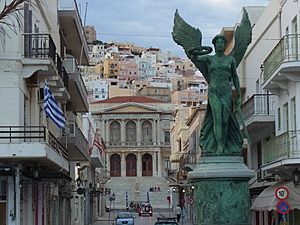
Fighting the Axis occupation was very risky. For the partisans, the main risk was death in combat against the much stronger German army. They also faced starvation and harsh conditions in the mountains, often with poor clothing and shoes.
Resistance also put ordinary Greeks at risk. Attacks on German soldiers often led to revenge killings of civilians. Villages were burned, and their people were massacred. The Germans also took hostages. They even set quotas for how many civilians would be killed in response to German soldiers being killed or wounded.
Main Resistance Groups
| Group name | Political ideas | Main leaders | Military arm | Military leaders | Estimated number of members |
|---|---|---|---|---|---|
| National Liberation Front (EAM) | Left-wing, connected to the Communist Party of Greece | Georgios Siantos | Greek People's Liberation Army (ELAS) | Aris Velouchiotis, Stefanos Sarafis | 50,000 fighters + 30,000 reserves (October 1944) |
| National Republican Greek League (EDES) | Pro-republic, nationalist, anti-communist | Nikolaos Plastiras (honorary), Komninos Pyromaglou | National Groups of Greek Guerrillas (EOEA) | Napoleon Zervas | 12,000 fighters + about 5,000 reserves (October 1944) |
| National and Social Liberation (EKKA) | Social-democratic, pro-republic, liberal | Georgios Kartalis | 5/42 Evzone Regiment | Dimitrios Psarros and Evripidis Bakirtzis | 1,000 fighters (spring 1943) |
Notable Resistance Members
|
EDES:
EAM/ELAS:
|
EKKA:
PEAN:
|
Other:
|
Images for kids



